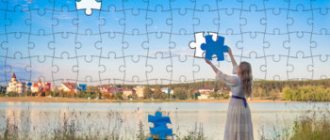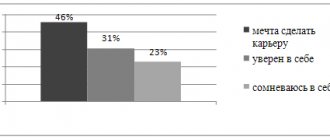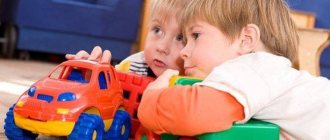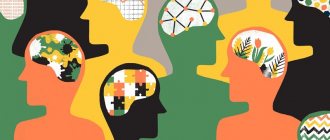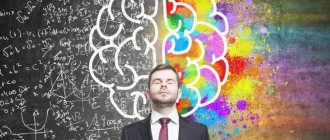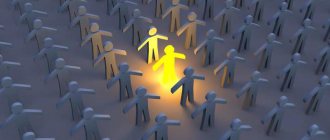One of the features that distinguishes a person from an animal is his ability, when coming into contact with the world around him, to observe, influence it, transform and create something new.
Moreover, often a person acts not limited by the framework of reality, but guided by his imaginary ideas. We will consider the mechanisms of imagination in psychology in this article.
The Essence of Imagination
What is imagination
Every image reproduced by a person is the embodiment of a modified reality.
Imagination is the process of creating new images by transforming ideas obtained in the surrounding reality.
When a person creates something new, he has in his mind an image that does not exist in reality, built thanks to his experience.
Imagination is closely related to memory, thinking and perception. Thanks to the connection between thinking and imagination, it is possible to get out of difficult life situations and solve problems with uncertain conditions.
If it is necessary to reproduce situations from past experience, then a person finds in his memory certain images that he had previously stored.
The perception of life would not be so bright and emotional without the participation of imagination. Throughout human evolution, the process of creating images has been involved not only in the development of work, but also in dreams and plans.
How to develop your imagination
Psychologists have identified a number of techniques for developing imagination.
In adults
The main thing is to be ready to experiment, not to be shy and not afraid of mistakes. There are many ways:
- Visualization. You need to mentally reproduce the appearance of an object, location or action. Start with simple tasks. For example, look at what lies in front of you. Then close your eyes and imagine this object in detail.
- Reading. This method is related to the previous one. Visualization is also needed here. It's just much more difficult to make it. You will have to remember several characters, images, landscapes at once. And after that, look at their participation in the plot. All this will help you see the full picture. And by the way, reading is much more interesting than watching movies. In the case of reading, no one limits your imagination and imagination.
- Associations. Every adult has associative thinking. Most likely, when you hear the word “green,” you think of grass and trees. And with the word “orange” - about an orange.
- Creation of unusual animals. This is a great way to develop your creative imagination. Let it be, for example, a cat dog. Of course, they don’t talk about it in a biology textbook. But you'll have fun. This exercise is suitable for both adults and children.
- Art. Exhibitions or master classes will make up for the lack of imagination. By observing other people, you yourself can easily create an unusual idea or at least get inspired.
- "Box". Here you will have to take an example from the cartoon character SpongeBob. Remember your favorite activity? He sat in the box and turned on his imagination. No, don't think that you need to do the same. Although children can try. Walk into an empty room and mentally design the interior. Next time, rearrange it, etc. This way you will improve your imagination and perception.
Another way is role-playing games. You control the hero, while observing certain requirements and conditions. Games can be tabletop or real. The latter include quests.
In children
It's a little easier with children. They already love to fantasize, often coming up with unusual stories and even imagining imaginary friends next to them.
How to develop children's imagination?
- Read fairy tales, fantasy stories. Try to read, for example, to the middle. And then invite the child to continue the story.
- Observe the people around you. Let the child think about how someone lives along the way. If you can’t go outside, use photographs or ordinary pictures. This way you can help develop the imagination of both preschoolers and older children.
- Go to exhibitions together, visit museums, cinemas.
- Get creative together. Model from clay and plasticine, make appliqués, draw, assemble car models, etc.
As with adults, role-playing games with parents or peers help children develop their imagination.
Types of imagination
Imagination can be intentional or unintentional.
Like memory processes, imagination processes are divided according to the degree of volitional effort into intentional and unintentional.
The unintentional work of the imagination takes place in daydreams, dreams, or half-asleep states.
Images are created spontaneously and in unusual combinations.
This is a passive process, independent of a person’s desires, in which his unmet needs are often embodied.
Intentional imagination is the deliberate process of creating specific images by a person of his own free will. He himself controls and directs his ideas depending on the situation, realizing the purpose and motives of his actions.
Arbitrary imagination has such forms as recreating (reproduction of an image according to its characteristics) and creative imagination (embodiment of a new image through one’s own conjecture).
Recreating imagination works when, having a specific description of an object, a person imagines its full image. For example, when reading fiction, a mental image of the characters or events described is formed.
Creative imagination is the creation of a new image through additions and transformations of an existing one. This kind of imagination is the basis of art.
In the process of creativity, active imagination mainly works, and the conscious formation of an image occurs. The Creator allows you to look at the world from a different perspective, using your means of expression.
Imagination and creativity
Creativity is the process of creating fundamentally new or improved methods for solving tasks and problems. It becomes obvious that imagination and the creative process are very interconnected.
Imagination here is defined as the transformation of ideas about reality and the creation of new images on this basis. It works every time a person thinks about some object or phenomenon, without even coming into direct contact with it. Thanks to creative imagination, the transformation of this idea is carried out.
Creative thinking and imagination have their own specific characteristics. Through this process, it is possible to create completely new, unique representations based on the subject's own ideas and thoughts, which express the personality of the creator. It can be voluntary or involuntary. To a large extent, creative imagination or inclination towards it is determined from birth, but it can also be developed.
The development of creative imagination occurs in three stages. At first, a creative idea arises. In the mind of the creator, a fuzzy image first appears, an initial idea that can be created arbitrarily, without purposeful comprehension of the idea. The second stage involves hatching a plan. A person thinks about strategies for translating an idea into reality and mentally improves it. The third stage completes the incubation of the idea and brings it to life.
The development of creative imagination is carried out in the process of transition from involuntary to voluntary, from recreating to creative. During childhood and adolescence, creative imagination has characteristic features; it is special for its magic, fantastic judgments about the world and the absence of a critical component of thinking and rationality. During adolescence, complex changes occur in the body, and therefore in consciousness as well. Objectivity is developed, perception becomes more critical. Rationality of perception appears a little later, when a person becomes an adult. The adult mind begins to control the imagination, often too much criticality and practicality weakens the processes of fantasy, overfilling them with meaning, loading them with some kind of information that is actually unnecessary.
There are certain methods for developing creative thinking. The most practical method is to read literature and watch scientific films, expand the range of your knowledge, draw knowledge from different areas of life, memorize and analyze information. In this case, a large amount of materials for creative processes appears.
Imagine imaginary objects, try to carry out various manipulations with them. For example, imagine the sea, hear the sound of breaking waves, feel the breath of sea freshness, imagine entering the water, feel its temperature, and so on. Or another example, imagine a pear. Imagine its shape, size, color. Use tactile perception, imagine it when it is in your hand, feel its surface, aroma. You can mentally take a bite of it and imagine the taste.
In order for the imagination to be voluntary, it is necessary to work on it through regular training. To make the effect even greater, you need to look for sources of inspiration, ask friends for help, and ask about their ideas. Try group work to create ideas, sometimes the results are very unique, and a person becomes more active if the process of imagination occurs in a circle of other creative individuals.
Physiological basis
Combinations of neural connections are formed at conscious and unconscious levels
Physiological processes responsible for the functioning of the imagination regulate the vital processes of the body.
Complex processes occur in the brain, during which nerve connections are activated and redistributed.
As a result of these processes, new neural combinations appear, which are the basis of the physiology of imagination.
Combinations of nerve connections are formed:
- at the unconscious level: from a spontaneous reaction in the cerebral cortex to various stimuli (for example, sleep or hallucinations);
- on a conscious level: in the process of a person’s independent creation of new images, several parts of the brain work (in all voluntary types of imagination).
The formation of new connections is not a random process; it can be described as the creative work of the brain.
Imagination influences many physiological processes: the functioning of organs, the level of activity of glands, metabolic processes. For example, when a person imagines a tasty dish, he salivates more.
When thinking about intense physical activity, you may notice subtle muscle activity. Consequently, imagination is closely related to human life processes and behavior.
Properties and meaning
Main properties of this ability:
- reproductive nature;
- integrity;
- dynamism, flexibility, versatility of the process;
- dependence of the accuracy of reconstruction on personality characteristics (level of knowledge, talent, life experience, upbringing, age).
Recreating imagination is of great importance because it helps to mentally imagine and predict the surrounding reality.
In activity, this is expressed in the ability to regulate cognitive processes, control events, formulate a plan of action, and determine the desired result.
Any anticipation of the expected result (guesses, intuition, premonitions, insights) is based on the reconstruction of existing ideas.
All significant achievements of mankind in the field of science, technology, literature, and fine arts occurred as a result of the work of individual people's recreating imagination , based on existing ideas and knowledge about the surrounding reality.
With the help of this process, a person can regulate not only his activities, but also change his emotional state.
For example, during stressful situations, you can bring to mind the images of loved ones or images of positive events from the past. This helps to lift your spirits and increase your belief in success.
Functions of the imagination
Sometimes imagination serves a protective function
The human brain cannot remain inactive for long, so people indulge in dreams.
For the imagination to work, it is not necessary to have new information or solve any problems.
It is known that it is very difficult for a person to stop the imagination and stop thinking at will.
During life, the human imagination performs many functions, the main of which are:
- regulatory – planning the future, presenting ways to achieve goals, regulating and programming activities and their results;
- cognitive – getting to know the world around you through concentration of attention, memory and thinking, activated by imagination;
- adaptive – presentation of complex phenomena and images through simpler ones;
- psychotherapeutic – creating psychological protection;
- affective – changing the emotional state, relieving tension.
Using his imagination, a person controls the processes occurring in the body, and also adapts to various situations. It is known that thanks to imagination you can change your heart rate, blood pressure and body temperature.
Role in activity
Recreating imagination plays a huge role in those types of human activities that do not involve the possibility of using practical experience .
Thus, historians describe events, eras and people from the past, relying on the impressions that arise in their minds.
These impressions are formed based on the information received.
Psychologists, sociologists, political scientists, philosophers, geographers, zoologists and many other specialists often do not have the opportunity to directly touch, hear, or study the objects they study.
Without reconstructive imagination, such types of activities would be reduced to mechanical memorization of known facts, and everything else would remain outside the scope of knowledge.
It should be borne in mind that the recreating imagination itself does not allow for effective implementation of activities if it is not based on real information.
That is, the ideas being recreated must correspond to reality and be correct.
The more extensively, accurately and accurately an individual’s ability to formulate intelligent conjectures is developed, the more reliable beliefs will ultimately be formed.
The role of imagination in human life
A good imagination is a necessary quality for success.
Unlike animals, man, with his ability to imagine, acts in the future, planning the future.
Imagination stimulates a person to action, forces him to go through a complex, multi-stage path, and encourages him to believe in the result of his work.
But, from another point of view, a dreamer satisfies his needs mentally, refusing real efforts.
Such a negative factor reduces a person’s activity, turning imagination against reality.
Fantasy plays a big role in the production of new inventions. Any modern, familiar object was a figment of human imagination hundreds of years ago.
Through imagination and hard work, new advances are constantly introduced into people's lives. A developed imagination is an essential ability of a successful person.
Features of imagination as a mental process
The creations of great artists and culinary recipes, vivid fantastic images created by the creativity of writers, and folk tales, ingenious inventions and new collections of famous fashion designers - all this was created thanks to the imagination. And our imagination is also associated with our fears, anxieties, hopes, dreams - everything that gives birth to our consciousness and subconscious. It is difficult to find at least one mental process that does not depend on this unusual phenomenon.
It is not for nothing that imagination is called the most amazing and mysterious phenomenon of the psyche, and, despite the long history of study, many mysteries related to it have not yet been solved. Read about how to develop your imagination here.
In a broad sense, imagination refers to the reproduction and transformation of images stored in memory. The second signaling system, that is, words-concepts, play a secondary role in the imagination, and more often act as catalysts that stimulate the process of creating new images. For example, we can imagine an animal we have never seen or a place we have never been to based on its verbal description.
Imagination and figurative thinking
Imagination operates with images, so it is not good friends with logic, and often is not controlled by logical thinking at all. This allows us to draw a conclusion about the antiquity of imagination as a form of human mental activity, and perhaps it is the very first abstract thought process that became accessible to our distant ancestors.
Unlike memory images, imagination products are not simply a reproduction of past experience, but its modification and transformation. All changes that occur with images are based on a person’s ability to:
- to information analysis;
- identifying its individual components;
- transforming them;
- subsequent synthesis of these elements in other combinations.
These transformations can be of varying degrees: some images differ only slightly from those stored in memory, others are not at all similar to them. A person can imagine both something that he has never seen (according to the description), and something that cannot even exist at all. Moreover, the products of imagination are also stored in memory in order to later participate in subsequent mental activity. Therefore, our consciousness, in alliance with the subconscious, can generate such a stunning “cocktail” of images that will surprise even ourselves.
Despite the amazing, incredible images created by our imagination, nothing completely new can be imagined. No matter how strange it may sound, a person can only imagine what he saw, heard, felt. However, our brain is capable of modifying elements of previous experience literally beyond recognition and creating new images from them, like from pieces of a mosaic.
The simplest examples of such combinatorial activity are well-known mythological and fairy-tale characters:
- Centaur is a combination of a human torso and the body and legs of a horse.
- The griffin is half eagle, half lion.
- And the Serpent-Gorynych is just a huge lizard with three heads and the wings of a bat.
More complex and multi-stage combinatorial activity makes it possible to create more complex images. In fact, all inventions of mankind arose in the same way.
Physiological basis of imagination
Like all mental processes, imagination is the result of the exchange of electrochemical impulses between neurons in the brain. During the passage of an impulse between the fibers of nerve cells, a protein molecule - a neurotransmitter - appears:
- Firstly, it provides communication between neurons.
- Secondly, it stores information about the passage of the signal, that is, it is the basis of our memory.
As a result of the passage of new impulses, new connections and entire neural networks are formed. Combinations of these connections are the physiological basis of imagination.
Despite such a simple explanation, the essence of imagination is not exhausted by it, and much of it remains incomprehensible. For example, the fact that the connection between physiological processes and images of the imagination is two-way. That is, not only real objects and situations, but also images generated by consciousness can lead to changes in the activity of our body. In fact, a person can “turn on” any reflex process himself, relying only on imagination.
As an example, let's conduct a small experiment. Please imagine that you have a lemon in your hands. Yellow, aromatic and, of course, sour. Introduced? Now imagine how you cut this yellow juicy lemon with a knife and bite into one of the halves, so that the juice begins to flow down your chin... How did you feel? That's right - a reflex reaction of salivation, and such that the sensation of acid made your cheekbones cramp. But the lemon is imaginary, its image is only in your mind.
- From imaginary danger we tremble and become cold with fear.
- The idea of imaginary grief brings tears to my eyes.
- At the thought of a completely hypothetical joy, a smile involuntarily appears on your lips.
The images we present give rise to absolutely real emotions, which also cause very real physiological changes in the body.
Many cases have been described when a person “invented” an illness for himself and actually began to experience a very real, and not imaginary, malaise. For example, cases of so-called stigmatism. Stigmas are bleeding wounds on the wrists of some exalted believers that occur when they imagine the suffering of Christ on the cross. These wounds are the result of high emotionality and a strong, vivid imagination.
However, a person can also heal himself, but for this he must have not only a strong imagination, but also confidence in his victory over the disease.
Stages of imagination development
Imagination is not an innate quality, and it can be developed
However, imagination is not an innate quality.
Its development occurs gradually, in the course of obtaining certain ideas that serve as the foundation for the creation of new images.
The development of imagination is promoted by personal self-improvement, education, training of memory, thinking and feelings.
It is difficult to limit the stages of imagination development by age category, since it depends on individual characteristics.
Based on some regularities, we can say that for the first time imagination is realized through perception. For example, it is difficult for a small child to imagine the plot of a fairy tale, but it is easier for him to imagine the situation happening to himself.
The connection between imagination and perception also manifests itself when the child transfers the received ideas into his games, mentally changing the appearance of objects. The work of imagination in childhood is always associated with activity, in this case – play.
At the stage when a child learns to speak, he begins to form not only images, but also more complex ideas. He has to find words to express what exists in his imagination.
It becomes easier for the child to separate the characteristics of an object from itself and use them to express other ideas. Images spontaneously arise and are combined in a child’s imagination.
At the next stage of imagination, the child can already deliberately recreate images. He begins to control his imagination during games and creative activities, imagining a goal or plot.
At the onset of school age, imagination rises one more level. Making efforts to complete learning tasks, the child actively recreates images and uses existing ideas.
What does imagination give to a person?
So, we found out what imagination is and what functions it plays. But why do you need it personally? There are several points:
- helps in communicating with other people;
- makes it possible to visualize the goal;
- promotes the development of creative talents;
- participates in decision making and creation of new ideas;
- helps you mentally recreate an image of an object or phenomenon that you have never seen.
Plus, imagination is used in making predictions and action plans for the future. It is needed in all areas of activity, especially in those that cannot be fully automated. We are talking about design, research work.
Does a child need imagination? The answer is clear: yes. Without it, full development is impossible. The first few years of a child's life explore the world around him. And if for some reason his imagination does not work at full strength, the formation of important abilities is inhibited.
The imagination developed in childhood will help an adult to become creative in the future, develop creative skills, and learn to find an unusual way out of a difficult situation. And this will be useful in life.
Mechanisms for creating images
Without imagination there would be no books and films
The images that arise in the imagination do not appear out of nowhere. They proceed from received ideas about real phenomena and objects.
Life impressions are combined in a person’s imagination, taking on various forms.
Imagination processes are divided into two levels:
- Analysis of impressions.
- Synthesis of the resulting images.
At the first level, ideas about an object are abstracted from other images, their components are separated, and analysis occurs. Subsequently, these images are transformed: combined into different combinations or reincarnated into completely new ideas.
This synthesizing process takes many forms. Agglutination is one of the common forms of synthesis, during which a new image is created by transferring the characteristics of one object to another.
In this way, images of ancient gods and mythical creatures were created in the imagination. The technique of agglutination is widely used in art and other creative processes.
For example, in order to draw a non-existent animal, it combined the features of various famous animals and birds. With the help of agglutination, parts of an object or the entire object are increased or decreased. This is how fairytale giants and gnomes were created.
By introducing existing ideas into new situations, new connections with completely different meanings are obtained. A person achieves correspondences in this combination by imagining the goal and controlling the process.
The synthesis of ideas is carried out through schematization and emphasis. Schematicization occurs as a result of insufficiently complete perception of the object. As a result, the holistic image may be distorted and inconsistent with reality.
Also, schematization can manifest itself when forgetting some properties of an object and representing it in a more generalized way. A person can consciously or unconsciously highlight certain features in an image.
Emphasis lies in focusing attention on the main properties of the image and creating a typical idea of the subject. In this complex creative process of generalization, a person identifies the main, in his opinion, features in the image and reflects reality through his own prism.
Creating images
A person creates images in the imagination in several ways:
- Agglutination. The qualities and parts of individual objects are combined into a single whole. Examples: centaur, fairy-tale hut on chicken legs, seaplane, snowmobile.
- Emphasis. Part of the object is divided into separate parts. A good example is caricatures in which the artist highlights a certain feature.
- Hyperbolization. Involves reducing, enlarging, or shifting individual parts of the selected object. Here you can also remember fairy tales, for example, about dragons with several heads.
Another way to create images in the imagination is typification. It is considered the most difficult. Imagine any picture. Contemplating it, you draw in your subconscious the image that the artist conveyed. Or take, for example, a book. The author describes in it the features of the main character. Thanks to this, you can imagine how he looks, thinks, behaves. It is as if you are transported into the world around him.
Individual characteristics of imagination development
Each person has a different degree of development of imagination, which is reflected in his activities and relationships in society. The individuality of people is that they differ in their own vision of the world.
The brightness of ideas and the novelty of transformed ideas depend on the degree of development of imagination. A strong imagination is an integral feature of artists, writers, sculptors, and directors.
It is difficult for a person with weak imagination to solve problems related to the mental design and representation of specific objects. An insufficiently developed imagination makes life less vibrant and emotional.
People differ significantly in the dominant types of imagination: visual, auditory, kinesthetic. But it happens that a person has highly developed all types, which is reflected in his character and behavior.
In this video you will learn about the psychology of imagination:
Example from life
I enjoy reading. Imagination helps you immerse yourself in the story. Even seemingly tedious descriptions of the area become much more interesting. I try to see the landscape through the eyes of the author, hear sounds, feel the wind or the scent of flowers.
The same goes for heroes. I try to imagine not only their appearance, but to monitor how their behavior and thinking changes in different situations. Thanks to this, after reading the book, it seems that I have visited this book world.
Mechanisms of imagination
- Agglutination (gluing) is the unification into a single whole of a number of ideas in a sequence different from our direct perceptions and experiences.
- Emphasis – emphasizing the most significant, typical features of an object.
- Hyperbolization and miniaturization - exaggeration and understatement, changing the proportions of elements involved in the process of imagination, or their parts. S.L. Rubinstein considered this imaginative technique to be one of the types of emphasis.
- Schematization is the selection of those properties of an element that are significant for the content of a specific act of imagination, the mental exclusion of some properties or qualities inherent in a particular object, getting rid of unnecessary and minor details.
Examples
The reconstructive imagination works most clearly in the process of cognitive activity .
Thus, during training, schoolchildren constantly imagine various images based on the information given to them by the teacher.
During a geography lesson, images of rivers, lakes, mountains and plains appear in the mind.
Natural phenomena in the form of a volcanic eruption, waterfall, earthquake have never been observed by most children in real life , but this does not prevent them from imagining them.
When hearing about historical events, children imagine battlefields, faces of government officials, buildings of past times, etc.
The more accurately, vividly and interestingly the teacher presents the material, the more reliable images are formed in the minds of students.
This helps to effectively perceive information and consolidate knowledge. Rote learning, which does not resonate with the imagination, does not allow the brain to work to its full potential.
fiction is no less significant .
A writer, when creating a work, is guided by his own fantasies and ideas.
Subsequently, readers who become acquainted with his creation project personal images in their minds . Moreover, the presence of specific descriptions and characteristics of characters, settings, and events never leads to the formation of uniform images among readers.
Each person, getting acquainted with a literary work, perceives it through the prism of his own ideas. It is for this reason that film adaptations of popular books cause a lot of controversy among their fans.
Every reader wants to see on the screen exactly the picture that his imagination drew while reading. This applies to the appearance of actors, interiors, nature, events, etc.
During the creation of the film adaptation, the director adheres to the images that the work evoked in his own mind .
Recreative imagination manifests itself systematically in everyday life. While waiting to meet a stranger, we involuntarily draw his image in our minds.
The basis can be information received from mutual friends, images in photographs, a voice heard on the phone, etc. When a real person turns out to be completely different from how we imagined him in our minds, we are convinced of the inaccuracy of the supposed image.
